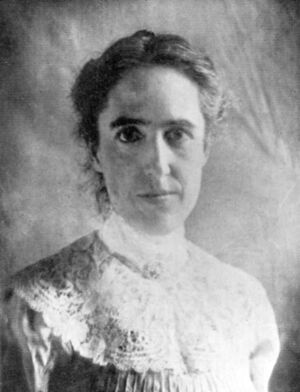Henrietta Swan Leavitt (nonfiction): Difference between revisions
No edit summary |
No edit summary |
||
| (2 intermediate revisions by the same user not shown) | |||
| Line 1: | Line 1: | ||
[[File:Henrietta_Swan_Leavitt.jpg|thumb|Henrietta Swan Leavitt.]]'''Henrietta Swan Leavitt''' (July | [[File:Henrietta_Swan_Leavitt.jpg|thumb|Henrietta Swan Leavitt.]]'''Henrietta Swan Leavitt''' (4 July 1868 – 12 December 1921) was an American astronomer who discovered the relation between the luminosity and the period of Cepheid variable stars. | ||
A graduate of Radcliffe College, Leavitt started working at the Harvard College Observatory as a "computer" in 1893, examining photographic plates in order to measure and catalog the brightness of the stars. | A graduate of Radcliffe College, Leavitt started working at the Harvard College Observatory as a "computer" in 1893, examining photographic plates in order to measure and catalog the brightness of the stars. | ||
| Line 16: | Line 16: | ||
== Fiction cross-reference == | == Fiction cross-reference == | ||
* [[Crimes against | * [[Crimes against astronomical constants]] | ||
* [[Gnomon algorithm]] | |||
* [[Gnomon Chronicles]] | |||
* [[Edwin Hubble (nonfiction)]] | * [[Edwin Hubble (nonfiction)]] | ||
* [[Vesto Slipher (nonfiction)]] | |||
== Nonfiction cross-reference == | == Nonfiction cross-reference == | ||
External links | == External links == | ||
* [https://en.wikipedia.org/wiki/Henrietta_Swan_Leavitt Henrietta Swan Leavitt] @ Wikipedia | * [https://en.wikipedia.org/wiki/Henrietta_Swan_Leavitt Henrietta Swan Leavitt] @ Wikipedia | ||
Latest revision as of 04:04, 12 December 2020
Henrietta Swan Leavitt (4 July 1868 – 12 December 1921) was an American astronomer who discovered the relation between the luminosity and the period of Cepheid variable stars.
A graduate of Radcliffe College, Leavitt started working at the Harvard College Observatory as a "computer" in 1893, examining photographic plates in order to measure and catalog the brightness of the stars.
Though she received little recognition in her lifetime, it was her discovery that first allowed astronomers to measure the distance between the Earth and faraway galaxies.
She explained her discovery: "A straight line can readily be drawn among each of the two series of points corresponding to maxima and minima, thus showing that there is a simple relation between the brightness of the variables and their periods."
After Leavitt's death, Edwin Hubble used the luminosity–period relation for Cepheids together with spectral shifts first measured by fellow astronomer Vesto Slipher at Lowell Observatory to determine that the universe is expanding (see Hubble's law).
In the News
Fiction cross-reference
- Crimes against astronomical constants
- Gnomon algorithm
- Gnomon Chronicles
- Edwin Hubble (nonfiction)
- Vesto Slipher (nonfiction)
Nonfiction cross-reference
External links
- Henrietta Swan Leavitt @ Wikipedia
